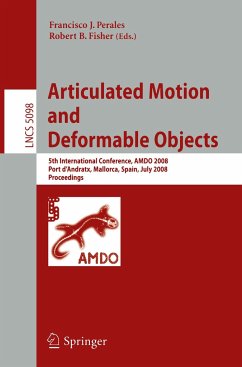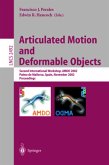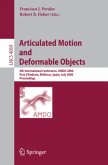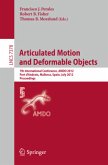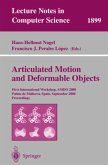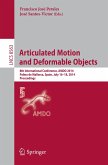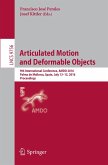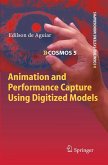Articulated Motion and Deformable Objects
5th International Conference, AMDO 2008, Port d'Andratx, Mallorca, Spain, July 9-11, 2008, Proceedings
Herausgegeben:Perales, Francisco J.; Fisher, Robert B.
Articulated Motion and Deformable Objects
5th International Conference, AMDO 2008, Port d'Andratx, Mallorca, Spain, July 9-11, 2008, Proceedings
Herausgegeben:Perales, Francisco J.; Fisher, Robert B.
- Broschiertes Buch
- Merkliste
- Auf die Merkliste
- Bewerten Bewerten
- Teilen
- Produkt teilen
- Produkterinnerung
- Produkterinnerung
This book constitutes the refereed proceedings of the 5th International Conference on Articulated Motion and Deformable Objects, AMDO 2008, held in Port d'Andratx, Mallorca, Spain, in July 2008.
The 36 revised full papers and 7 poster papers presented were carefully reviewed and selected from 64 submissions. The papers are organized in topical section on computer graphics: human modelling and animation, human motion: analysis, tracking, 3D reconstruction and recognition, multimodal user interaction: VR and ar, speech, biometrics, and advanced multimedia systems: standards, indexed video contents.…mehr
Andere Kunden interessierten sich auch für
![Articulated Motion and Deformable Objects Articulated Motion and Deformable Objects]() Francisco J. Perales / Edwin R. Hancock (eds.)Articulated Motion and Deformable Objects39,99 €
Francisco J. Perales / Edwin R. Hancock (eds.)Articulated Motion and Deformable Objects39,99 €![Articulated Motion and Deformable Objects Articulated Motion and Deformable Objects]() Francisco J. Perales (Volume ed.) / Robert B. FisherArticulated Motion and Deformable Objects40,99 €
Francisco J. Perales (Volume ed.) / Robert B. FisherArticulated Motion and Deformable Objects40,99 €![Articulated Motion and Deformable Objects Articulated Motion and Deformable Objects]() Articulated Motion and Deformable Objects39,99 €
Articulated Motion and Deformable Objects39,99 €![Articulated Motion and Deformable Objects Articulated Motion and Deformable Objects]() Hans-Hellmut Nagel / Francisco J. Perales (eds.)Articulated Motion and Deformable Objects39,99 €
Hans-Hellmut Nagel / Francisco J. Perales (eds.)Articulated Motion and Deformable Objects39,99 €![Articulated Motion and Deformable Objects Articulated Motion and Deformable Objects]() Articulated Motion and Deformable Objects37,99 €
Articulated Motion and Deformable Objects37,99 €![Articulated Motion and Deformable Objects Articulated Motion and Deformable Objects]() Articulated Motion and Deformable Objects76,99 €
Articulated Motion and Deformable Objects76,99 €![Animation and Performance Capture Using Digitized Models Animation and Performance Capture Using Digitized Models]() Edilson de AguiarAnimation and Performance Capture Using Digitized Models76,99 €
Edilson de AguiarAnimation and Performance Capture Using Digitized Models76,99 €-
-
-
This book constitutes the refereed proceedings of the 5th International Conference on Articulated Motion and Deformable Objects, AMDO 2008, held in Port d'Andratx, Mallorca, Spain, in July 2008.
The 36 revised full papers and 7 poster papers presented were carefully reviewed and selected from 64 submissions. The papers are organized in topical section on computer graphics: human modelling and animation, human motion: analysis, tracking, 3D reconstruction and recognition, multimodal user interaction: VR and ar, speech, biometrics, and advanced multimedia systems: standards, indexed video contents.
The 36 revised full papers and 7 poster papers presented were carefully reviewed and selected from 64 submissions. The papers are organized in topical section on computer graphics: human modelling and animation, human motion: analysis, tracking, 3D reconstruction and recognition, multimodal user interaction: VR and ar, speech, biometrics, and advanced multimedia systems: standards, indexed video contents.
Produktdetails
- Produktdetails
- Lecture Notes in Computer Science 5098
- Verlag: Springer / Springer Berlin Heidelberg / Springer, Berlin
- Artikelnr. des Verlages: 12327829, 978-3-540-70516-1
- Seitenzahl: 476
- Erscheinungstermin: 1. Juli 2008
- Englisch
- Abmessung: 235mm x 155mm x 26mm
- Gewicht: 715g
- ISBN-13: 9783540705161
- ISBN-10: 3540705163
- Artikelnr.: 24424181
- Herstellerkennzeichnung
- Springer-Verlag KG
- Sachsenplatz 4-6
- 1201 Wien, AT
- ProductSafety@springernature.com
- Lecture Notes in Computer Science 5098
- Verlag: Springer / Springer Berlin Heidelberg / Springer, Berlin
- Artikelnr. des Verlages: 12327829, 978-3-540-70516-1
- Seitenzahl: 476
- Erscheinungstermin: 1. Juli 2008
- Englisch
- Abmessung: 235mm x 155mm x 26mm
- Gewicht: 715g
- ISBN-13: 9783540705161
- ISBN-10: 3540705163
- Artikelnr.: 24424181
- Herstellerkennzeichnung
- Springer-Verlag KG
- Sachsenplatz 4-6
- 1201 Wien, AT
- ProductSafety@springernature.com
Inverse Kinematics Using Sequential Monte Carlo Methods.- Estimation of Dense, Non-rigid Motion Fields from a Multi-camera Array Using a Hierarchical Mixture Model.- Learning to Look at Humans - What Are the Parts of a Moving Body?.- Continuous Hand Gesture Recognition in the Learned Hierarchical Latent Variable Space.- Real-Time 3D Body Pose Tracking from Multiple 2D Images.- Applying Space State Models in Human Action Recognition: A Comparative Study.- Bone Glow: An Improved Method for the Assignment of Weights for Mesh Deformation.- Analysis of Human Motion, Based on the Reduction of Multidimensional Captured Data - Application to Hand Gesture Compression, Segmentation and Synthesis.- Exploiting Structural Hierarchy in Articulated Objects Towards Robust Motion Capture.- Estimating Human Skeleton Parameters and Configuration in Real-Time from Markered Optical Motion Capture.- Dealing with Self-occlusion in Region Based Motion Capture by Means of Internal Regions.- Model-Based Analysis and Synthesis of Time-Varying Mesh.- Mesh Vertex Pose and Position Interpolation Using Geometric Algebra.- An Audiovisual Talking Head for Augmented Speech Generation: Models and Animations Based on a Real Speaker's Articulatory Data.- Towards Efficiency in Cloth Simulation.- 2D Articulated Body Tracking with Self-occultations Handling.- A Two-Step Approach for Detecting Individuals within Dense Crowds.- 3D Modeling for Deformable Objects.- Active-Vision System Reconfiguration for Form Recognition in the Presence of Dynamic Obstacles.- View-Invariant Human Action Detection Using Component-Wise HMM of Body Parts.- A Generative Model for Motion Synthesis and Blending Using Probability Density Estimation.- Gestural Interaction Using Feature Classification.- Predicting Missing Markersto Drive Real-Time Centre of Rotation Estimation.- Accurate Human Motion Capture Using an Ergonomics-Based Anthropometric Human Model.- A Deformable Surface Model with Volume Preserving Springs.- Temporal Nearest End-Effectors for Real-Time Full-Body Human Actions Recognition.- Fusing Edge Cues to Handle Colour Problems in Image Segmentation.- Body-Part Templates for Recovery of 2D Human Poses under Occlusion.- Autonomous Virtual Agents for Performance Evaluation of Tracking Algorithms.- A Manipulable Vision-Based 3D Input Device for Space Curves.- A Comparative Study on Using Zernike Velocity Moments and Hidden Markov Models for Hand Gesture Recognition.- Deformable Volumetric Simplex Meshes.- Analytical Simulation of B-Spline Surfaces Deformation.- Apperance-Based Tracking and Face Identification in Video Sequences.- Interactive Constrained Deformations of NURBS Surfaces: N-SCODEF.- A 3D Shape Descriptor for Human Pose Recovery.- Fast Detection and Modeling of Human-Body Parts from Monocular Video.- Kinetic Pseudo-energy History for Human Dynamic Gestures Recognition.- An Improved Algorithm for Estimating the ICA Model Concerning the Convergence Rate.- Automatic Adjustment of Rigs to Extracted Skeletons.- Real-Time Recognition of Human Gestures for 3D Interaction.- Effective Emotional Classification Combining Facial Classifiers and User Assessment.- Online and Offline Fingerprint Template Update Using Minutiae: An Experimental Comparison.- Users with Disabilities: Maximum Control with Minimum Effort.
Inverse Kinematics Using Sequential Monte Carlo Methods.- Estimation of Dense, Non-rigid Motion Fields from a Multi-camera Array Using a Hierarchical Mixture Model.- Learning to Look at Humans - What Are the Parts of a Moving Body?.- Continuous Hand Gesture Recognition in the Learned Hierarchical Latent Variable Space.- Real-Time 3D Body Pose Tracking from Multiple 2D Images.- Applying Space State Models in Human Action Recognition: A Comparative Study.- Bone Glow: An Improved Method for the Assignment of Weights for Mesh Deformation.- Analysis of Human Motion, Based on the Reduction of Multidimensional Captured Data - Application to Hand Gesture Compression, Segmentation and Synthesis.- Exploiting Structural Hierarchy in Articulated Objects Towards Robust Motion Capture.- Estimating Human Skeleton Parameters and Configuration in Real-Time from Markered Optical Motion Capture.- Dealing with Self-occlusion in Region Based Motion Capture by Means of Internal Regions.- Model-Based Analysis and Synthesis of Time-Varying Mesh.- Mesh Vertex Pose and Position Interpolation Using Geometric Algebra.- An Audiovisual Talking Head for Augmented Speech Generation: Models and Animations Based on a Real Speaker's Articulatory Data.- Towards Efficiency in Cloth Simulation.- 2D Articulated Body Tracking with Self-occultations Handling.- A Two-Step Approach for Detecting Individuals within Dense Crowds.- 3D Modeling for Deformable Objects.- Active-Vision System Reconfiguration for Form Recognition in the Presence of Dynamic Obstacles.- View-Invariant Human Action Detection Using Component-Wise HMM of Body Parts.- A Generative Model for Motion Synthesis and Blending Using Probability Density Estimation.- Gestural Interaction Using Feature Classification.- Predicting Missing Markersto Drive Real-Time Centre of Rotation Estimation.- Accurate Human Motion Capture Using an Ergonomics-Based Anthropometric Human Model.- A Deformable Surface Model with Volume Preserving Springs.- Temporal Nearest End-Effectors for Real-Time Full-Body Human Actions Recognition.- Fusing Edge Cues to Handle Colour Problems in Image Segmentation.- Body-Part Templates for Recovery of 2D Human Poses under Occlusion.- Autonomous Virtual Agents for Performance Evaluation of Tracking Algorithms.- A Manipulable Vision-Based 3D Input Device for Space Curves.- A Comparative Study on Using Zernike Velocity Moments and Hidden Markov Models for Hand Gesture Recognition.- Deformable Volumetric Simplex Meshes.- Analytical Simulation of B-Spline Surfaces Deformation.- Apperance-Based Tracking and Face Identification in Video Sequences.- Interactive Constrained Deformations of NURBS Surfaces: N-SCODEF.- A 3D Shape Descriptor for Human Pose Recovery.- Fast Detection and Modeling of Human-Body Parts from Monocular Video.- Kinetic Pseudo-energy History for Human Dynamic Gestures Recognition.- An Improved Algorithm for Estimating the ICA Model Concerning the Convergence Rate.- Automatic Adjustment of Rigs to Extracted Skeletons.- Real-Time Recognition of Human Gestures for 3D Interaction.- Effective Emotional Classification Combining Facial Classifiers and User Assessment.- Online and Offline Fingerprint Template Update Using Minutiae: An Experimental Comparison.- Users with Disabilities: Maximum Control with Minimum Effort.

